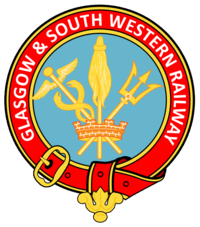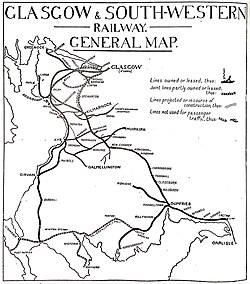
Back Glasgow and South Western Railway German Glasgow and South Western Railway Portuguese Glasgow and South Western Railway SCO
 | |
 | |
| Overview | |
|---|---|
| Headquarters | Glasgow |
| Locale | Scotland |
| Dates of operation | 1850 – 1923 |
| Predecessor | Glasgow, Paisley, Kilmarnock and Ayr Railway and Glasgow, Dumfries and Carlisle Railway |
| Successor | London, Midland and Scottish Railway |
| Technical | |
| Track gauge | 4 ft 8+1⁄2 in (1,435 mm) standard gauge |
| Length | 493 miles 38 chains (794.2 km) (1919)[1] |
| Track length | 1,141 miles 64 chains (1,837.5 km) (1919)[1] |
The Glasgow and South Western Railway (G&SWR) was a railway company in Scotland. It served a triangular area of south-west Scotland between Glasgow, Stranraer and Carlisle. It was formed on 28 October 1850 by the merger of two earlier railways, the Glasgow, Paisley, Kilmarnock and Ayr Railway and the Glasgow, Dumfries and Carlisle Railway. Already established in Ayrshire, it consolidated its position there and extended southwards, eventually reaching Stranraer. Its main business was mineral traffic, especially coal, and passengers, but its more southerly territory was very thinly populated and local traffic, passenger and goods, was limited, while operationally parts of its network were difficult.
It later formed an alliance with the English Midland Railway and ran express passenger trains from Glasgow to London with that company, in competition with the Caledonian Railway and its English partner, the London and North Western Railway, who had an easier route. In 1923 the G&SWR formed a constituent of the London Midland and Scottish Railway group.
Much of the network remains active at the present day; Glasgow commuting particularly has developed, and parts of the network have been electrified. Many of the earlier mineral workings, and branches constructed to serve them, have ceased, and many local passenger stations in rural areas have closed.
In 1921 the G&SWR had 1,128 miles (1,815 km) of line (calculated as single track extent plus sidings) and the company’s capital was about £19 million.